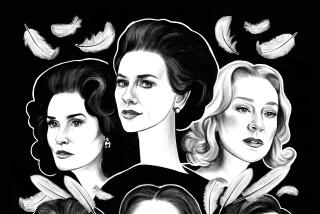‘UNTOUCHABLES’ MOVIE AS SILLY AS THE TV SERIES
- Share via
It’s been a rotten 1986-87 for Al Capone.
First, Geraldo Rivera discovers that Capone’s secret vaults are empty. And now comes a theatrical movie--named for “The Untouchables” TV series--that depicts Capone as so monstrous that he causes saintly Eliot Ness to become a vicious animal just to keep pace.
The infamous Capone was Chicago’s crime boss during Prohibition, with operations that reportedly grossed $120 million annually. But U.S. Treasury agent Ness and his small group of handpicked agents put the skids to the scar-faced gangster in 1931.
This is not the only TV series to be spun off, however loosely, as a feature film: Witness the knot of “Star Trek” movies and the coming “Dragnet 1987” with Tom Hanks and Dan Aykroyd.
“The Untouchables” ran on ABC from 1959 to 1963, drawing heat for its violence and its depictions of gangsters as Italians. If the series were made today, Ness’ crimebusters would be required to be demographically correct and include one black, one Hispanic, one Asian and one female. And so as not to offend Italians, Al Capone would have to be renamed Al Brown.
How does “The Untouchables” movie, written by David Mamet and directed by Brian De Palma, compare with the black-and-white Desilu TV series, which piled up almost as many bodies as rating points and which is still in syndication?
-- The Basics: Ness and his guys are more heroic and Capone and his guys are an easier mark in the movie than in the series.
In the movie, Ness needs only three incorruptible men--a twirpy accountant, an aging street cop and a raw recruit--to ruin Capone. That’s awesome. In the series, Ness commanded six “Untouchables,” all upstanding he-men in three-piece suits. The actual number of “Untouchables” was 10.
What’s more, the movie Ness (Kevin Costner) is a married family man who occasionally smiles, while the TV Ness (Robert Stack) was single and humorless. In the movie, Frank (the Enforcer) Nitti is a demonically sadistic hit man who doesn’t survive the story. In the series, Nitti was more visible than Capone and in fact is Ness’ main antagonist while Capone is in jail.
In addition, the TV series was narrated by Walter Winchell. The movie has no narrator, but try real hard and you can understand the story without assistance.
-- The Story: “The Untouchables” of TV was utterly mindless and predictable, spraying lead and splattering blood and body parts across thin plots and thinner characters.
“The Untouchables” movie is an improvement, being only partially mindless and predictable. De Palma provides a great period look and generates entertainment, excitement and suspense. But if the movie and its characters are bigger than life, so are its flaws. Mamet’s script, which he all but disclaims in an American Film magazine article, contains gaping holes.
City guys inexplicably being expert horsemen? A tough, savvy lawman inexplicably making himself an easy and inviting target for mob assassins? And an absurd, laughable blowout ending that defies explanation?
These would be ridiculed as vacuous in a TV production, and rightfully so. But when bearing the stamp of a name director on the big screen, other explanations occur, such as that “The Untouchables” might be a parody. Yet producer Art Linson said two years ago that hiring Mamet meant that “we didn’t want to do a parody,” and he promised that Mamet would “look at these characters in a very real way.”
-- The Performances: There’s at least a hint of life in Costner’s Ness. This indication of breathing gives him an automatic edge over Stack’s calcified Ness, who got more action from his trigger finger than from his face. “The Untouchables” was that kind of series.
Robert De Niro’s movie Capone wins big over Neville Brand’s cartoonish Capone of TV. And Billy Drago’s frightening Frank Nitti makes Bruce Gordon’s TV Nitti look like Albert Schweitzer. The movie’s best performance is turned in by Sean Connery as Ness’ right-hand man, Malone, who has no counterpart in the series.
-- The authenticity: Both the movie and TV series are set in Chicago, which exists. Beyond that, you’re on your own.
Nitti’s death in the movie is about 17 years premature, for example. The real Nitti was found shot to death in 1948 after being indicted by a grand jury, and his death was ruled a suicide.
When it came to fantasy, however, the TV series took no back seats. After Capone went to jail, the real Ness disbanded his “Untouchables” and later became Cleveland’s safety director (ultimately to commit suicide himself). Yet on TV, Ness and his “Untouchables” were shown post-Capone, continuing their Chicago anti-crime blitz and even taking on such mobsters as Ma Barker and Dutch Schultz and helping foil an attempt to assassinate President Roosevelt in 1933.
--The Violence: The series was the most senselessly violent TV programming of its time. You could always count on one or two mobsters being blown away or impaled on a meat hook per episode, or something equally grisly happening. The movie’s violence has far more impact, though, because the killing is even bloodier, more concentrated and magnified on a big screen.
-- The Messages of Both Versions of “The Untouchables”: Here’s where they come together. They tell you that ends justify means, because defeating a monster requires becoming a monster. Message No. 2: Don’t believe everything you see on TV or in the movies.
More to Read
Only good movies
Get the Indie Focus newsletter, Mark Olsen's weekly guide to the world of cinema.
You may occasionally receive promotional content from the Los Angeles Times.










